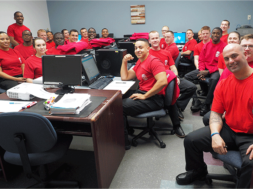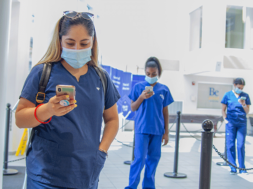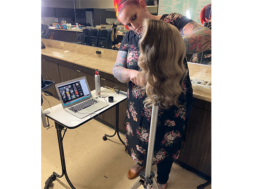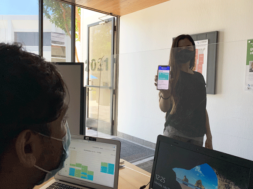
Could iPads Replace Textbooks?
By Chris Georgetti, President & Managing Director, Santoro & Georgetti Postsecondary Educational Consultants
As an early adopter of technology, I generally try to stay current on the latest trends and what can be used in the educational market for the betterment of students. Early in 2011, I began to research what it would take to offer iPads to the new and current students at Florida Technical College.
According to Apple employees at that time, the major textbook publishers such as Pearson and McGraw-Hill were rapidly trying to convert many of their textbooks into .epub formats. I brought the idea to the then CEO of the school, and we discussed the pros and cons of such an investment.
The benefits we envisioned were clear:
- Students would have instant access to their textbooks for each class, and we never needed to worry about late shipments, etc. Because it is difficult to always secure orders due to demand; having the ability to let our publishers know how many new students we had each month made it an easy way to fulfill the orders. This reduced the shipping cost and also lowered the cost to the students as eBooks are much cheaper than paperback textbooks.
- When a student would enroll in multiple classes, they didn’t have to carry heavy textbooks all around the campus any longer. One of the areas we consistently would hear critiques on was the size and weight of the books. Students didn’t like to carry multiple heavy textbooks to each class, and it generally had more of a “high school” feel when they had to carry multiple books in a backpack around the campus.
- Students had access to a wealth of additional material that was updated in real time instead of texts that may contain outdated material. Giving the faculty the opportunity to use current material always benefited the students in ways a printed book could not. They were able to link web material to lectures and bring data into the classroom that they never could before.
- Faculty could utilize Apple TV’s in the classrooms and make coursework more interactive and fun with proper training. Having the ability to tap on a webinar or livestream was something at that time that was generally reserved for a boardroom meeting or work presentation. The students were suddenly given the opportunity to hear lectures from other campuses and other faculty members. In addition, they were also able to interact with business owners and managers during guest lectures from multiple locations. This allowed faculty to utilize employers in ways they never had before because employers didn’t to walk on campus to speak with students physically, and faculty scheduled many more lectures in conjunction with the employers.
- Admissions personnel had an exciting and academically engaging product to market to potential students. During the initial enrollment interview, they were able to display to a student the advantage of using the technology in ways that competitors couldn’t. Since many institutions wouldn’t make the investment required, we were one of the first institutions to offer this, and it quickly became a competitive advantage.
What many institutions don’t know (and we didn’t either) the hurdles a college must jump over and through in order to properly implement such an endeavor.
While in discussions with Apple, we quickly realized that there would be the need for a major capital expenditure even though the cost of an iPad would be paid as a supply charge to the student. The college had to purchase the iPad initially and then wait for the Title IV in order to recoup the cost. As you can imagine, if a student dropped out of school before the money being received and they didn’t return the iPad, the college would lose that investment.
Inventory control and ordering became a tricky proposition for us because we were constantly trying to make sure on a weekly basis just how many new students would need an iPad. This helped us forecast much more accurately because if we missed a projection and ordered too many, the cost would be for nothing until the next start occurred.
There were several checks and balances set up to keep them all secure while awaiting distribution from month-to-month but we perfected it to a science after some trial-and-error. This also caused teamwork between our IT staff and our accounting departments as they worked hand-in-hand to maintain proper inventory counts and controls.
Theft of the iPads was not something we saw coming, but it happened because nobody cared about a textbook on a desk in a classroom while students were on break but an iPad laying there was a much different story.
It became important enough that we added it to the initial training program that was given by Apple employees during each distribution to the students. We educated them on keeping it as closely guarded as their own cell phones.
We also discovered after the initial rollout to the current students who were on campus; that bandwidth became a very real problem. When students started to access the wireless networks inside of the college, it put a severe strain on the entire network and eventually, a huge investment had to be made in order to support those strains or the entire project could not be continued.
As one could imagine, outfitting an entire location with enough access points, Apple TV’s, projectors, screens and a network that could handle 1000’s of iPads downloading books, streaming data and all the other things wireless devices are used for was a cost-intensive endeavor for the entire organization.
We also ran into issues when trying to distribute eBooks for certain programs. As stated earlier, Pearson and McGraw-Hill had begun to convert many of their texts in areas such as allied health and business, but they hadn’t had the time to convert criminal justice, law, beauty programs and hospitality textbooks; all of which the college was offering. They did convert as fast as possible, but the college still had to offer textbooks for certain programs until the texts were all converted for all of the courses.
However, once all of the challenges were overcome, and the devices were issued to the students, rarely did we ever hear complaints.
With the ability to bookmark pages, highlight a section, draw on the pages and all of the other advantages that using eBooks provided; students were very happy to keep all of their notes and information in one safe and secure place while also having a tool that would quickly become ingrained in our technological society and is rather commonplace today.
The entire IT department became iPad experts and supported the students after the initial distribution and the college continued to hold training sessions for those students who weren’t comfortable making the shift from textbooks. In fact, the main issue we would hear was that people still liked the feel of the paper in their hands and it took a lot of students some time to “let go” of the idea of a hardbound textbook.
In the end though, we found that most students felt that being able to participate in lectures with real-time data and utilizing the technology helped them in achieving their educational goals. Textbooks can only be updated at certain times by publishers, and that has been an accepted practice for a very long time, but with this advent of technology, they quickly embraced the idea of updating things much more frequently.
One of the best parts of the entire journey was interviewing students to see how they felt about the idea and getting feedback from them. Like many proprietary colleges, there were many older students who were concerned they wouldn’t be able to navigate the iPad as the younger students would.
It took a lot of educating by faculty and administrators for those students, but once they received their iPad and started using it, everyone felt better about the process.
The Apple store employees that we contracted with were very professional and courteous and always worked with the students and the college when hiccups occurred. Their level of customer service was excellent, and we tried to take a page out of their book in working with our students after they completed the initial training.
Schools should involve students in the initial phases and seek their input in deciding on initiatives that involved their education. It could be as small as classroom hour offerings or as large as something like this but getting them involved and keeping them updated throughout the process makes a transition go smoother in the long run.
In today’s current environment of education, we at Santoro and Georgetti Consulting believe in technology and the advantages that it presents in the classroom and beyond. A student sitting in Orlando, Florida can interact with a faculty member who is experienced in dealing with a new surgical procedure in another country and watch as that procedure is done live.
A few short years ago, things like that had to be found on the internet and on one’s own time where now, faculty can collaborate across different colleges and different oceans and assist one another in providing lectures and new perspectives to the students who rightly deserve it.
Whether a college is considering something for their entire institution or just one program, contacting a professional to seek advice and hear about potential missteps is crucial. We didn’t think we would experience all of the issues we did or need the training involved when undertaking the iPad endeavor, but we quickly learned that even with as much due diligence as we performed; there were many areas that presented themselves to us quicker than anyone imagined.
In our opinion and in today’s market, there isn’t another medium that can provide the wealth of information available that can be given to students and allow them to have real-time updates, current information and the ability to communicate with groups all around the world quite like they can on an iPad.
We are proponents of the technology but we are even bigger supporters of educating students with the best possible tools that encourages them to think bigger and work smarter so if you feel another device is better, then we encourage you to invest in that for your students because regardless of the type of device they use; giving them the tools and then supporting them with training, encouragement and overall guidance is what they need from you on a daily basis.
In summary, technology should never replace solid interaction between human beings, and there will always be something to be said for a faculty member delivering a strong lecture that can impact and educate a student in a way that resides within them forever. However, using updated information and giving them additional ways to acquire information like never before is nothing but a bonus for faculty and students on a daily basis and iPads can deliver that in an instant.
CHRIS GEORGETTI is a Postsecondary Educational Consultant with comprehensive experience in all areas of campus management including acquisitions, startups, relocation and in-depth knowledge of the management of schools/colleges both inside of the campuses and at the corporate levels. He has been affiliated with the For-Profit Postsecondary Education arena since 1998 and served in a variety of roles.
He has worked in a variety of roles over the last 18 years which detail his acumen for understanding the sector and working with leaders both inside and outside of the daily campus operations. His most recent role as the Senior Vice President of Operations for the EduK Group served the Florida and Puerto Rico markets that managed 39 main campuses and branch locations. They are the largest provider of postsecondary education for the Hispanic community with over 23,000 students and annual revenues of $145 Million. His areas of expertise are widespread throughout campus operations and corporate management. He has held roles including Professor, Academic Dean, Admissions Director, Vice President of Operations and President, making him a wealth of information that serves both for-profit and not-for-profit schools.
Contact Information: Chris Georgetti // President & Managing Director // 407-257-8568 // G@SandGconsult.com // www.SandGconsult.com // http://www.linkedin.com/company/sandgconsulting // https://www.facebook.com/SandGEducationConsulting/











